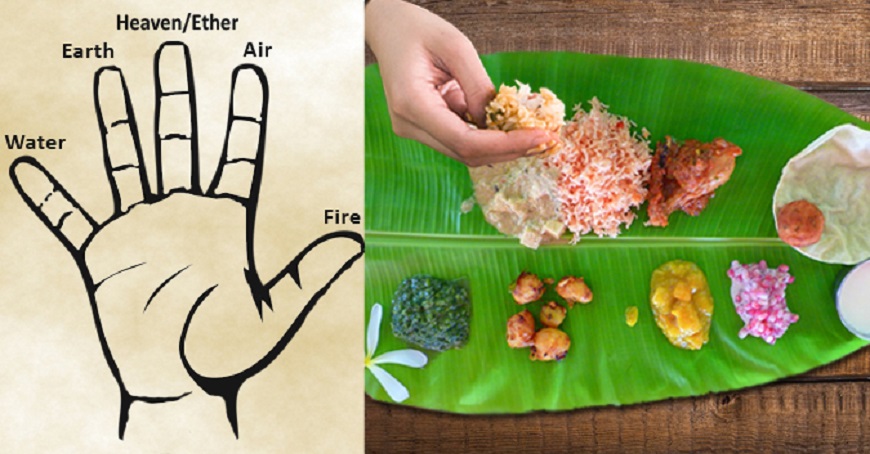Why Do South Asians Eat Food Using Their Hands? The Philosophy Behind the Practice

Eating with one’s hands is a common practice in South Asia, encompassing countries like India, Pakistan, Sri Lanka, Bangladesh, and Nepal. Though it might seem unusual to outsiders, it’s a tradition rooted in philosophy, culture, and connection to food and nature. The practice of hand-eating is deeply interwoven with ancient beliefs and philosophies that view food as a sacred source of nourishment and energy. Let’s explore the significance behind this cultural practice and why, for many South Asians, eating with hands is an act that goes beyond simply consuming food.
1. Connecting with Food on a Sensory Level
Eating with hands involves more than just taste; it’s a multisensory experience that engages touch, smell, and sight. When we eat with our hands, we engage with the texture, warmth, and feel of the food, which enriches the sensory experience.
According to ancient Ayurvedic philosophy, touch is essential to our relationship with food. By touching food, we become more conscious of it and engage with it as something that sustains and nourishes us. The temperature, texture, and consistency of each bite are felt, allowing a person to judge whether the food is just right for consumption. Touch plays a critical role in activating the digestive system by signaling to the body that food is about to be eaten, preparing it to release digestive enzymes.
2. The Five Elements Theory: A Balance of Nature
South Asian philosophy, especially in Ayurveda, believes that everything in the universe, including our bodies, is composed of five elements: earth, water, fire, air, and space. Each finger is thought to represent one of these elements. By eating with our hands, we symbolically bring these elements into harmony before food enters our bodies. Here’s how each finger corresponds to an element:
- Thumb – Fire
- Index finger – Air
- Middle finger – Space (or ether)
- Ring finger – Earth
- Little finger – Water
The belief is that when these elements are in balance while eating, the digestive process becomes smoother, and food is absorbed more effectively. The connection to these elements through touch makes the act of eating sacred and creates a harmonious experience that honors both the body and nature.
3. A Spiritual Practice of Mindfulness and Gratitude
In South Asian traditions, eating is often considered a sacred ritual, and hand-eating plays a role in fostering a mindful and grateful approach to food. Instead of hastily consuming food with utensils, eating with hands encourages people to slow down, savor each bite, and truly appreciate the meal. Many families say a short prayer or offer gratitude before eating, acknowledging the hard work of those who grew, prepared, and served the food.
In Hinduism, food is often offered to deities as “prasadam” before being eaten, symbolizing that it is sacred and worthy of respect. By eating with hands, there is an intentional gesture of gratitude toward the food itself, recognizing it as a gift that sustains life.
4. Enhancing Digestion through Physical Connection
Science has shown that digestion begins in the brain. When we touch food with our hands, the nerves in our fingers send signals to our brain, triggering the release of digestive enzymes in anticipation of the meal. This physical connection activates the digestive system and can help prepare the body for the upcoming nourishment.
Moreover, it’s believed that our hands contain beneficial bacteria, which serve as an extra layer of defense for the body. These bacteria, known as “normal flora,” exist on our skin and play a role in digestion and overall immunity. Hand-eating, therefore, is seen as an act that can help promote gut health, aligning with traditional practices that emphasize balance and natural health.
5. Symbolizing Equality and Humility
In South Asia, eating with hands represents a form of humility and equality. Traditionally, it doesn’t matter if one is rich or poor, a high-ranking official or a farmer—everyone eats with their hands, breaking down social barriers and creating a shared experience around food. It reflects a cultural attitude that sees food as a universal gift, meant to be shared and enjoyed without the layers of formality imposed by utensils.
Hand-eating is especially common during festivals, family gatherings, and religious ceremonies. In these settings, people often eat on a banana leaf or shared platters, fostering a sense of unity, humility, and togetherness. Sharing a meal in this way becomes a reminder that food is a gift meant to nourish all people equally, regardless of social status.
6. Honoring Tradition and Cultural Identity
Eating with hands is a practice passed down through generations, carrying with it the wisdom of ancestors and the essence of cultural heritage. For many South Asians, continuing this practice is a way to honor tradition and cultural identity. It connects them to their roots and reinforces a sense of belonging and continuity with the past.
By choosing to eat with hands, South Asians keep alive a tradition that values nature, spirituality, and family. This act of eating becomes a way of reinforcing identity and holding onto values in a rapidly modernizing world. In a way, it’s an expression of resistance against cultural erasure and an affirmation of the uniqueness of their heritage.
7. The Healing Power of Food and Mindful Eating
Hand-eating also reflects the traditional belief that food has healing properties and that the act of eating should be approached with care and intention. By touching food, we connect to its energy, which is thought to have the power to heal and revitalize the body. This practice aligns with Ayurvedic principles that emphasize the need for balance, harmony, and respect for nature.
Hand-eating encourages mindfulness by forcing us to slow down and focus on the food we are eating. This slows the eating process, allowing time for signals of fullness to reach the brain, which helps prevent overeating. In a world filled with distractions, where people often eat quickly or while on the go, eating with hands serves as a reminder to be present and to appreciate the simple, nourishing act of consuming food.
Conclusion: A Celebration of Nature, Culture, and Connection
Eating with hands in South Asia is a practice deeply rooted in spirituality, philosophy, and respect for nature. Far from being a mere cultural habit, it’s a mindful ritual that connects people to their food, the earth, and each other. In a world where fast food and convenience often overshadow traditions, eating with hands stands as a reminder of the beauty of simplicity and the value of honoring ancient customs.
Through this act, South Asians celebrate a deeper connection to nature and their ancestors, finding joy in a practice that promotes mindfulness, gratitude, and community. For many, eating with hands is not only a cultural symbol but a way of life—one that honors food, respects tradition, and embraces the wisdom of generations past.
Best Healthy Snacks Subscription Boxes in India: Where to Order Online With hectic work routines, family duties, and little time to cook, sticking to a healthy diet has become tougher than ever in modern life. While most of us would say it is easier to grab a quick snack, many of these snacks are not […]
Prompts and AI: The New Communication Skill of the Digital Age In the fast-paced digital age, AI is no longer just a technology of the future but rather an everyday tool. Using voice-activated virtual assistants to create reminders or using AI systems to generate creative ideas shows how dependent we are now on prompts, which […]




